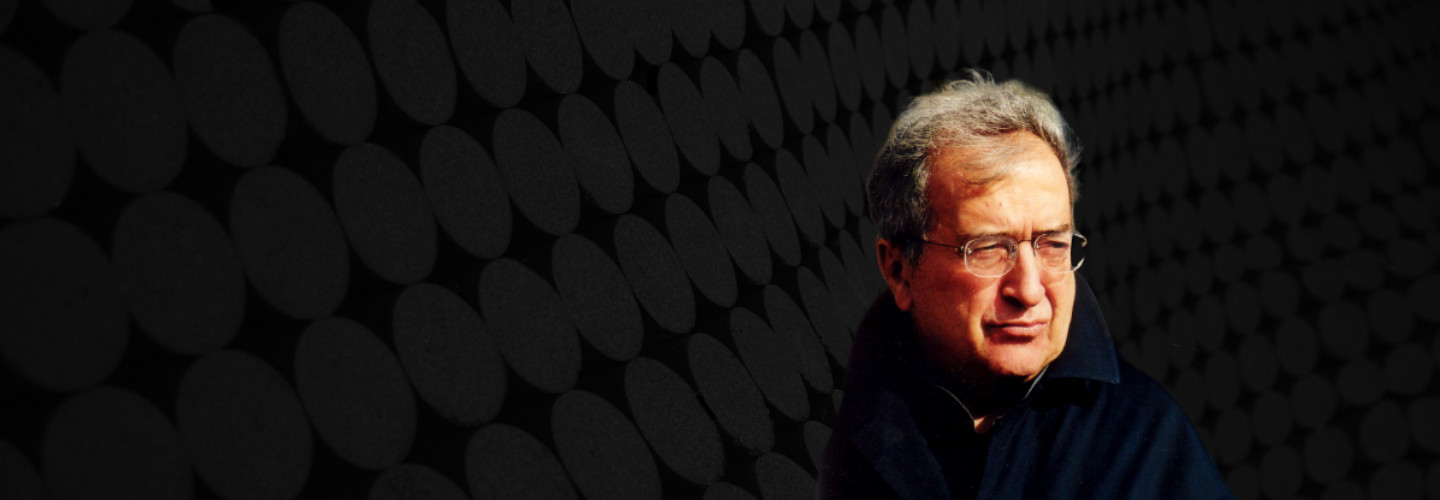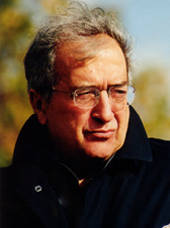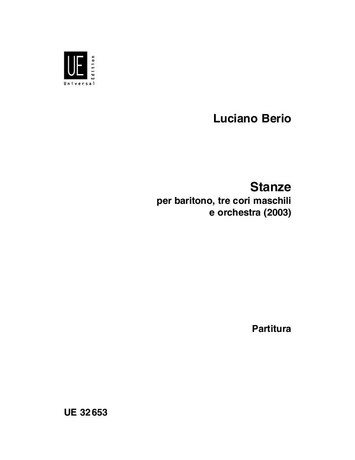

Luciano Berio
Stanze
Short instrumentation: 4 3 5 3 - 4 4 3 1 - perc(3), glock, pno, alto sax(2), t.sax, str(12 12 12 8 8)
Duration: 25'
Text von: Giorgio Caproni, Alfred Brendel, Dan Pagis, Edoardo Sanguineti, Paul Celan
Übersetzer: Talia Berio, David Osmond-Smith
Dedication: per Renzo Piano
Choir: TTTBBB
Solos:
baritone
Instrumentation details:
piccolo
1st flute
2nd flute
3rd flute
1st oboe
2nd oboe
cor anglais
clarinet in Eb
1st clarinet in Bb
2nd clarinet in Bb
3rd clarinet in Bb
bass clarinet in Bb
1st alto saxophone in Eb
2nd alto saxophone in Eb
tenor saxophone in Bb
1st bassoon
2nd bassoon
contrabassoon
1st horn in F
2nd horn in F
3rd horn in F
4th horn in F
1st trumpet in C (+slide whistle)
2nd trumpet in C (+slide whistle)
3rd trumpet in C (+slide whistle)
4th trumpet in C (+slide whistle)
1st trombone
2nd trombone
3rd trombone
bass tuba
1st percussion (guiro, maracas, tam-tam, 2 bongos, bass drum & hi-hat)
2nd percussion (tubular bells, tam-tam, snare drum)
3rd percussion (guiro, whip, 2 maracas, triangle, 3 tam-tams, 2 bongos)
glockenspiel
piano (+cel)
violin I(12)
violin II(12)
viola(12)
violoncello(8)
contrabass(8)
Berio - Stanze for baritone, 3 small male choirs and orchestra
Printed/Digital
Translation, reprints and more

Luciano Berio
Berio: Stanze for baritone, 3 small male choirs (TTTBBB) and orchestraOrchestration: for baritone, 3 small male choirs (TTTBBB) and orchestra
Type: Studienpartitur
Language: Deutsch | Englisch | Italienisch
Sample pages
Audio preview
Work introduction
“We are not dealing with stanzas, or strophes, with a poetic composition or an old song. Rather, we are dealing with actual rooms (stanze) that have doors and windows, like the habitable spaces of a building. Each room is inhabited by a different poem (by Paul Celan, Giorgio Caproni, Edoardo Sanguineti, Alfred Brendel and Dan Pagis) that evokes the ironic, anguished or detached image of an unmentionable other and other place.”
With these few words Luciano Berio sketched the profile of his last composition. The notion of “an unmentionable other and other place” that is not to be reduced to the idea of the Christian God, expresses the spirituality of a non-believer for whom God can only be “a concept”. It was for this reason that Berio was fascinated with the Jewish religion, “where the concept of God is first and foremost a truth to be conquered” (interview in “la Repubblica”, 20 December 2002: the following quotations are taken from the same source). In the Jewish religion, the journey is more important than the destination, “as with great music, where the formal process is more important than the form. In other words, it is the journey that counts. The exodus is an extraordinary emblem of this”. A religion devoid of the idea of God as a definitively acquired identity also allows conceptual space for the hypothesis of a secular spirituality, of a critical approach and a cognitive attitude. In short: “God is a concept. As such, He can be approached and studied in the most diverse of ways”.
This is the profound meaning of Stanze, where “the idea of God is present in different situations, mental rooms” which communicate with each other. In their reciprocal confrontations, the substances that inhabit them do not engage in a mutual definition, but instead become ever more elusive, more unmentionable, amplifying the eternal question of the meaning of things. With Brendel we find ourselves before “an ironic God. In Caproni, God is almost a blasphemous entity, in Sanguineti he is elusive and labyrinthine, in Celan he is a kind of peremptory capital letter, in Dan Pagis he is guilty. We are, in other words, dealing with ‘Rooms’ whose doors and windows are ever open”.
The alternation between different perceptions of God and death brings with it changes not just to our attitudes, but to the function of music in relation to poetry. Within a symmetrical structure of five conjoined panels, there are moments when an intimate compenetration and amplification of textual meanings is established. That is what happens between the first (Paul Celan) and the last (Dan Pagis) poem; whereas in the second (Giorgio Caproni) and the fourth (Alfred Brendel), it is instead the onomatopoeic and citational functions that prevail – thus giving them a more extrovert and immediate character. In the central panel (Sanguineti) music takes on the function of creating a rarefied and suspended ambience for the intimate dialogue between Berio and the poet. Choosing the poetry of Celan (Tenebrae) to open the composition and that of Pagis (Die Schlacht, The Battle) to close it acquires programmatic weight: reference to the theme of the Shoah frames the work in grieving meditation, unavoidable in any reflection on the existence of God - an accusation directed at a God who is guilty for having allowed this to happen.
Berio shows punctilious respect for the poetic integrity of the texts. At times he removes minor details which in music could seem superfluous. At other times, the cuts indicate specific poetic choices: in Caproni’s poems he omits the line “By now I have reached both destination and despair”, which would work against the composer’s reticence in emphasizing personal expression. Rather than display individual sentiments, Berio prefers the motions of the collective soul (“the poet of sentiment, heart in hand, gives me the creeps!”). So the choice of these texts reflects how Berio’s sympathies have always flowed through collective experience. And as in the rest of his vocal work, there is no painting or translation into sound of individual meanings, but rather a global, structural reading of the text; an overall setting that focuses on a few key concepts, sometimes just one.
Berio ensures the perceptibility of the text through the baritone’s plain, syllabic delivery, while reserving for the chorus some of his most effective and simple techniques for breaking up syllables and vowels so as to amplify the sonority of the words. The homogeneity of the male voices gives a characteristic timbre to Stanze. Separating the three choruses creates effects of spatialisation to which the non-traditional arrangement of the orchestra also contributes. Berio adds to the choruses three non-homogeneous but balanced instrumental groups, which are joined by three percussionists and three saxophones that, as in previous compositions, often function as soloists. Listening to the score live and analysing it more deeply may help to clarify the complex functions of this orchestral disposition, upon which the composer worked for a long time.
The poetry of Celan appears for the first time in the music of Berio in the epigraph (a line from Argumentum e silentio) assigned to Notturno for string quartet (1993). It returns as a text (Die Posaunenstelle) for setting in Hör for chorus and orchestra (1995), which in turn becomes the central chorus of cycle III from Outis (1996). In Cronaca del luogo (1999) Celan is one of the poets quoted in the text of the ‘scenic action’, written by Talia Pecker Berio. In all of these cases, Celan is presented as a poet of the Shoah and of Jewish culture, and it is in the same light that he appears in the first part of Stanze. The “peremptory capital letter” seems to become petrified in the repetition of the word “Herr” (Lord), ‘nailed’ to the baritone’s low A, and pronounced in a more strongly accusatory tone than are the others. With the words “zur Tränke gingen wir, Herr. Es war Blut...“ (we went to the drinking trough, Lord. It was blood...) the smooth surface of the harmonic fields becomes agitated by a series of repeated blows. Yet here it is only a momentary gesture of rebellion. Only later, at the end of the sentence “Wir haben getrunken, Herr. Das Blut und das Bild, das im Blut war, Herr. Bete, Herr.” (We drank, Lord. The blood and the image that was in the blood, Lord. Pray, Lord.) does it become invective. For here the peremptory word (Herr) frees itself from the low A and sounds louder and higher. The premise of a good God prayed to by sinners is subverted: a God that sheds blood must pray for the innocent victims.
Congedo del viaggiatore cerimonioso (the ceremonious traveller’s farewell) by Giorgio Caproni is a clear metaphor for death; “what time I arrive” and “where I change trains” are uncertain, yet it is evident that the train is fast approaching the traveller’s goal. The metaphor is translated by Berio into the realistic imitation of train noises: the pressing rhythms of the percussion (bongos, snare drum, maracas), the whistling of the flutes à coulisse, the puffing of the steam engine imitated by the whispered voices of the chorus, the long braking of the train imitated by the shaking of the maracas. The chorus takes apart some syllables of the text and repeats them mechanically, onomatopoeically. The mimesis, although recognisable, conserves a high level of abstraction, and concentrates principally upon the emotional impact of the symbol of the train: distance, nostalgia, emigration, deportation... The unexpected interruption of the percussion’s obsessive rhythm produces an unexpected and disturbing void corresponding to the final word: “goodbye”.
Sanguineti’s text (“a free manipulation of fragments from Job”, as the poet himself defined it) constitutes the heart of Stanze. Berio draws from it a suspended and rarefied atmosphere, expectant and amazed before a “monstrous God” who manifests Himself in Nature, sometimes in a cruel and capricious way, but not as a guilty party. A mythological God who needs to create man in order to give a meaning to his own freedom of action. The voice’s movement is similar to speech, entirely suspended amidst sudden, accented unisons that distend themselves through quietening glissandi into pianissimo clusters – explosions of distant stars dissolved into twinkling specks of dust; or, vice versa, the clusters concentrate themselves through ever-louder glissandi into a unison – the constellations implode, recuperating their original solidity. The succession of sudden and unexpected sonic events creates a disorienting polyphony of unisons and clusters. Here more than anywhere, one perceives the non-traditional disposition of the instruments: a sort of stereophony renders unexpected even the origin of the sonorous events in space. The chorus catches up certain of the soloist’s vowel sounds and expands them into long resonances; or instead, humming, they create the softest of harmonic backdrops. In the central part, the strings function as a sound-object, as a generator of timbre, with high-register clusters sliding slowly downwards. There are some enchained “explosions”, cosmic rebounds, infinite velocities; and then the final immobile harmonic pedal.
The idea of an “elf-god” who conceals himself amongst the notes of the younger Johann Strauss’s Tritsch-Tratsch-Polka and Kaiser-Walzer might well seem blasphemous. Yet in the poem by Alfred Brendel one can discern, beyond the biting and irreverent irony, a libertarian invitation to seek the presence of God even in lightheartedness. Thus in Berio’s reading – which is certainly rich in humour, as witnessed by the frequent vocalizations in falsetto – one finds not so much a parodistic and desecrating intent, but rather a jovial yet well-concealed use of quotation (in this, very different to the 3rd movement of Sinfonia, which hinges upon recognisable themes and harmonies). In this fourth Stanza (the only one of the five to have been performed separately, in an initial version, on the occasion of the Brendel’s seventieth birthday in 2001) the rhythm of the polka is obvious, as is its occasional intertwining with waltz rhythm, but the quotation from the Tritsch-Tratsch-Polka is not as evident. The harmonic material that gives life to the entire composition occasionally coagulates into the rhythmic gestures that characterize Strauss’s dance (acciaccaturas, fragments of descending scales, rushes of ascending semi-quavers, a characteristic use of percussion), yet quotation only becomes apparent at the conclusion. Here what shines through is not so much sarcasm, as the slightly sceptical and nostalgic smile of one who has not abandoned his belief – even when faced with the great existential questions – that in the end everything is a game.
Yet it is a profound understanding of human pain that has the last word. In the verse of the Israeli poet Dan Pagis (Die Schlacht, The Battle), the image of the Shoah takes us over in its full horror: the dead come together “with enormous and estranged eyes” at the edge of the grave, while a guilty God arbitrarily ordains who will be damned and who blessed. Yet it is a sedimented pain, over which seems to spread, like a balsam, a continuous sheet of harmony that slowly and gradually changes. It is a flat surface of changing density, that every so often lets the light shine through, a polyphony of timbres whose almost imperceptible movement is disturbed only by the sparkling clusters of the celesta. A violin melody is continuously repeated with small variations, like a litany. Shifting shadows of vowels taken from the baritone part, of isolated words and of hummed sounds, spread from one chorus to the next and back again. The disturbing image of mouths, wide open but silent, refers back to the analogous image in Celan’s poem: “Augen und Mund stehen so offen und leer” (Eyes and mouth stand so wide and empty: Berio expressly chose a German translation of Pagis’s Hebrew original so as to establish a symmetrical relationship with Celan’s poem); and it is precisely the verb “schweigen” (to keep silent) that provokes a reaction of indignation - the first forte of this setting. It generates a wave building to a convulsion of horror in the face of an unjust and arbitrary divine judgement (“Wer weiß, wer verflucht wer gesegnet im verbrannten Staub.” Who knows who is damned, who blessed, in the burnt dust). A fortissimo explodes into violent shuddering in the orchestra, and a chilling howl of indeterminate pitch from the chorus. Yet a composed and settled pain returns; the composition ends with the same low A to which Celan’s “peremptory capital letter” was nailed: the guilty God, unmentionable and ineluctable.
I would like to thank Talia Pecker Berio for her invaluable help with the writing of this text.
Marco Uvietta
